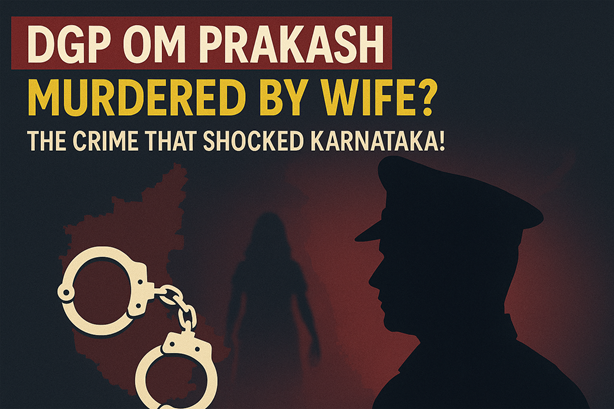The Day a Top Cop Was Killed at Home
The law enforcement world was shaken when news broke that retired Karnataka Director General of Police (DGP) Om Prakash had been murdered in cold blood — allegedly by his wife, Pallavi. The crime took place on a quiet Sunday afternoon in their Bengaluru residence and has since sparked nationwide headlines, legal debates, and public outrage.

This wasn’t a crime by a stranger or an armed intruder — it was a brutal killing from inside his own home, and allegedly at the hands of the person closest to him.
Table of Contents
What Happened on April 20, 2025?
At around 3:30 PM, Om Prakash was reportedly having lunch when things took a horrific turn.
According to police investigations:
- Pallavi threw chilli powder in his eyes, incapacitating him.
- She then attacked him with two knives and a broken glass bottle, stabbing him multiple times.
- The fatal injuries led to his instant death.
Shortly after the attack, Pallavi is said to have video-called a neighbour and confessed:
“I have killed the monster.”
The neighbour quickly alerted the authorities, who arrived to find Om Prakash lying in a pool of blood. Pallavi was taken into custody immediately.

Was This Just a Crime of Passion — Or Something More?
While the murder was shocking, the backstory made it even more complex.
In the days leading up to the incident, Pallavi had reportedly sent WhatsApp messages to friends and relatives, alleging:
- Her husband was poisoning her.
- She was being kept under constant surveillance.
- She feared for her life.
These messages are now being examined by investigators and may become a key part of her defense. Her claim? That years of domestic abuse and psychological trauma led her to break.
Family Tensions Explode: A Son’s Allegations
Adding another layer to the tragedy is the role of the couple’s son, Kartikeya.
He was the one who filed the police complaint — and he didn’t defend his mother. On the contrary, Kartikeya accused both his mother and sister, Kruthi, of threatening his father’s life in the past.
According to him:
- Om Prakash had moved out for a while due to death threats from Pallavi and Kruthi.
- Just two days before the murder, Kruthi had persuaded her father to return home.
- He believes this was a planned murder, not a spontaneous act.
Kruthi was detained and questioned but was later released. Police noted that both women were emotionally unstable during the initial investigation.
Who Was DGP Om Prakash?
Om Prakash was a 1981 batch IPS officer from Bihar, who went on to become the Director General of Police in Karnataka. Known for his discipline, administrative skill, and long tenure in the police force, he retired in 2017 after a prestigious career.
His sudden and tragic death has left colleagues and law enforcement officials across the country stunned and saddened. He was cremated on April 21, 2025, with full state honours.
The Legal Angle: What the Murder of DGP Om Prakash Means for Indian Criminal Law
The brutal killing of retired DGP Om Prakash has evolved into a high-stakes legal drama, and since the crime occurred in April 2025, the case falls entirely under the Bharatiya Nyaya Sanhita, 2023 (BNS) — India’s newly enforced criminal code that replaced the IPC from July 1, 2024.
Let’s break down the key legal angles using the updated legal framework.
1. Charge Under Section 101 of BNS – Murder
The core charge against Pallavi is under Section 101 of the BNS, which pertains to murder:
“Whoever commits murder shall be punished with death or imprisonment for life, and shall also be liable to fine.”
Here’s why this section applies:
- The act was intentional and fatal, with multiple stabs and use of sharp weapons.
- There was preparation involved — like chilli powder used to blind the victim.
- The confession and eyewitness admission add strength to the prosecution’s case.
Still, this charge is only the beginning — what will determine the final outcome are the psychological and circumstantial complexities around the incident.
2. Possible Defense: Section 22 of BNS – Unsoundness of Mind
Pallavi’s defense may invoke Section 22 of the BNS, which mirrors the earlier insanity defense under IPC Section 84.
It states:
“Nothing is an offence which is done by a person who, at the time of doing it, by reason of unsoundness of mind, was incapable of knowing the nature of the act…”
If Pallavi can prove:
- She suffered from serious mental illness or emotional breakdown,
- Her perception of threat or abuse altered her sense of reality,
- She was incapable of understanding the criminal nature of her act,
…then this section may offer her a legal shield.
But this defense is notoriously difficult to prove. It demands strong medical records, psychiatric evaluations, and credible past history — none of which have been produced yet, but may emerge during trial.
3. Downgrading the Crime: Grave Provocation or Self-Defense
Under Exceptions to Section 101, if Pallavi’s legal team can argue that:
- The act was committed under grave and sudden provocation, or
- It was a reaction to chronic domestic abuse, or
- It was in fear of death or grievous harm,
…the murder charge could be downgraded to “culpable homicide not amounting to murder”, punishable under Section 104 of BNS.
This distinction is crucial because it could:
- Eliminate the possibility of capital punishment,
- Reduce the sentence to less than life imprisonment, depending on circumstances.
4. Role of Kruthi: Abetment or Conspiracy Charges?
Om Prakash’s son, Kartikeya, accused his sister Kruthi of previously threatening their father and luring him back home days before the murder.
If the police uncover supporting evidence, Kruthi could face:
- Section 61 of BNS – Abetment of an offence, or
- Section 62 of BNS – Criminal conspiracy, if it is proven she actively helped plan the murder.
So far, she has not been formally charged, but her role remains under scrutiny.
5. Sentencing: Death Penalty vs Life Imprisonment
Even if Pallavi is convicted under Section 101:
- Her lawyers can argue for mitigating circumstances, including mental trauma, lack of prior criminal record, and age.
- The court may reject the death penalty and opt for rigorous life imprisonment.
Additionally, the emerging role of mental health in Indian criminal jurisprudence could influence sentencing — especially if the court accepts the killing was a consequence of prolonged emotional and psychological suffering.
While Pallavi has confessed, her legal team may present the case as one of psychological breakdown, provocation, or even long-term emotional and physical abuse. Adultery n divorce are also increasing exponentially in India.
What the Case Means for Society and the Law
This murder is not just a criminal case — it’s a mirror to some uncomfortable truths.
- Domestic violence isn’t always a man-on-woman issue. The roles can be reversed — and just as dangerous.
- The case highlights the need for mental health awareness within families, especially among homemakers often living in isolation.
- It also underscores how power, fear, and silence can coexist within even the most influential households.
Indian courts have historically taken a cautious approach when it comes to crimes involving domestic provocation. This case might set a new precedent, especially if psychological abuse becomes a serious consideration in the final judgment.
The Nation Watches
The murder of DGP Om Prakash has turned into a case that the entire country is watching — not just for the verdict, but for the truth behind it.
What really happened inside that home?
Was this a planned act of revenge? A cry for help? Or a moment of mental collapse?
As the investigation continues and courtroom drama unfolds, one thing is certain: the story of Om Prakash and Pallavi is far from over.
Final Thoughts
This chilling case reminds us that violence doesn’t wear a uniform — and trauma doesn’t always scream out loud. What seems perfect on the outside might be hiding deep scars within.
Whether Pallavi is ultimately found guilty of murder, or the case reveals a darker psychological narrative, one life is lost — and another is shattered.
[…] However, the application varies based on the relationship dynamics. In the landmark case of Gangu v. Chandrabhagabai (1907), the court held that a wife could inherit property from her murdered father-in-law if her claim was based on her own right as “gotraja-sapinda” rather than through her murderous husband. This exception demonstrates that the answer to can the wife inherit any property after killing her husband depends on the specific inheritance pathway claimed. Recently in a case DGP Om Prakash was Murdered by Wife. […]